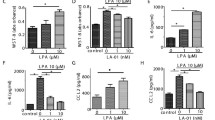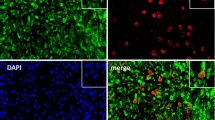Abstract
We examined the intracellular mechanisms of substance P induced oxyradical production in rheumatoid synovial cells by the luminol-dependent chemiluminescence method. After stimulation with substance P (30 μM), single synovial A (macrophage-like) or B (fibroblast-like) cells released oxyradicals such as superoxide anions (OZ) and/or hypochlorous anions (OCl−) under a microscope equipped with an ultrasensitive photonic image intensifier. The substance P induced oxyradical production was blocked by a tachykinin NK1 (NK1) receptor antagonist, GR82334, GTP-binding protein (G-protein) inactivators, GDPβS and islet-activating protein (IAP), and a phospholipase C (PLC) inhibitor, U-73122. Substance P (30 μM) also induced a transient increase in the intracellular Ca2+ concentration ([Ca2+]i) in both synovial A and B cells as measured by a Ca2+ indicator, fura 2. BAPTA-AM and an inositol-1,4-5-triphosphate (IP3) receptor antagonist, heparin, inhibited the substance P induced increase in [Ca2+]i, but they had no effects on oxyradical production. In contrast to the effects of BAPTA-AM and heparin, protein kinase C (PKC) inhibitors, H-7 and calphostin C, completely inhibited substance P induced oxyradical production without any significant effects on [Ca2+]i increase. These findings suggest that the NK1 receptor/PLC-linked diacylglycerol (DAG) formation with the resulting activation of PKC is the main signal transduction pathway for substance P stimulated oxyradical production in synovial cells.
Similar content being viewed by others
References
Ritchlin CT, Wincheter RJ (1989) Potential mechanism for coordinate gene activation in the rheumatoid synoviocyte: implication and hypothesis. Springer Semin Immunol 11:219–234
Case JP, Lafyatis R, Remmers EF, Kumkumian GK, Wilder RL (1989) Transin/stromelysin expression in rheumatoid synovium. Am J Pathol 135:1055–1064
Zvaifler NJ, Firestein GS (1994) Pannus and pannocytes: alternative models of joint destruction in rheumatoid arthritis. Arthritis Rheum 37:783–789
Lafyatis R, Thompson NL, Remmers EF, Flanders KC, Roche NS, Kim S-J, Case JP, Sporn MB, Roberts AB, Wilder RL (1989) Transforming growth factor-β production by synovial tissues from rheumatoid patients and streptococcal cell wall arthritic rats: studies on secretion by synovial fibroblast-like cells and immunohistologic localization. J Immunol 143:1142–1148
Trabandt A, Aicher WK, Gay RE, Sukhatme VP, Hamilton MN, Hamilton RT, McGhee JR, Fassbender HG, Gay S (1990) Expression of the collagenolytic and Ras-induced cystein proteinase cathepsin L and proliferation-associated oncogenes in synovial cells of MRL/I mice and patients with rheumatoid arthritis. Matrix 10:349–361
Larsson J, Ekblom A, Henriksson K, Lundeberg T, Theodorsson T (1989) Immunoreactive tachykinins, calcitonin gene-related peptide and neuropeptide Y in human synovial fluid from inflamed knee joints. Neurosci Lett 100:326–330
McGillis JP, Mitsuhashi M, Payan DG (1990) Immunomoduration by tachykinin neuropeptides. Ann NY Acad Sci 594:85–94
Kimball ES (1990) Substance P, cytokines, and arthritis. Ann NY Acad Sci 594:293–308
Lotz M, Carson DA, Vaughan JH (1987) Substance P activation of rheumatoid synoviocytes: neural pathway in pathogenesis of arthritis. Science 235:893–895
Menkes CJ, Renoux M, Laoussadi S, Mauborgne A, Bruxelle J, Cesselin F (1993) Substance P levels in the synovium and synovial fluid from patients with rheumatoid arthritis and osteoarthritis. J Rheumatol 20:714–717
Serra MC, Bazzoni F, Bianka VD, Greskowiak M, Rossi F (1988) Activation of human neutrophils by substance P: effect on oxidative metabolism, exocytosis, cytosolic Ca2+ concentration and inositol phosphate formation. J Immunol 141:2118–2124
Tanabe T, Otani H, Bao LH, Mikami Y, Yasukura T, Ninnomyiya T, Ogawa R, Inagaki C (1996) Intracellular signaling pathway of substance P-induced superoxide production in human neutrophils. Eur J Pharmacol 299:187–195
Tan EM, Cohen AS, Fries JF (1982) The 1982 revised criteria for the classification of systemic lupus erythematosus. Arthritis Rheum 25:1271–1277
Bathon JM, Proud D, Krackow K, Wigley FM (1989) Preincubation of human synovial cells with IL-1 modulates prostaglandin E2 release in response to bradykinin. J Immunol 143:579–586
Suematsu M, Oshio C, Miura S, Tsuchiya M (1987) Real-time visualization of oxyradical burst from single neutrophil by using ultrasensitive video intensifier microscopy. Biochem Biophys Res Commun 149:1106–1110
Allen RC, Loose LD (1976) Phagocytic activation of a luminoldependent chemiluminescence in rabbit alveolar and peritoneal macrophages. Biochem Biophys Res Commun 69:245–252
Lad PM, Olson CV, Grewal IS, Scott SJ (1985) A pertussis toxin-sensitive GTP-binding protein in the human neutrophil regulates multiple receptors, calcium mobilization, and lectin-induced capping. Proc Natl Acad Sci USA 82:8643–8647
Grinstein S, Furuya W (1991) Tyrosine phosphorylation and oxygen consumption induced by G protein in neutrophils. Am J Physiol 260:C1019-C1027
Smith CD, Snyderman R (1987) Guanine-nucleotide regulatory proteins in receptor-mediated polyphosphoinositide hydrolysis in human leukocytes. Methods Enzymol 141:261–271
Edwards SW (1987) Luminol- and lucigenin-dependent chemiluminescence of neutrophils: role of degranulation. J Clin Lab Immunol 22:35–39
Simmonds NJ, Allen RE, Stevens TRJ, Van Someren RNM, Blake DR, Rampton DS (1992) Chemiluminescence assay of mucosal reactive oxygen metabolites in inflammatory bowel disease. Gastroenterology 103:186–196
Smith RJ, Sam LM, Justen JM, Bundy GL, Bala GA, Bleasdale JE (1990) Receptor-coupled signal transduction in human polymorphonuclear neutrophils: effects of a novel inhibitor of phos pholipase C-dependent processes on cell responsiveness. J Pharmacol Exp Ther 253:688–697
Meyer T, Stryer L (1990) Transient calcium release induced by successive increments of inositol 1,4,5-triphosphate. Proc Natl Acad Sci USA 87:3841–3845
Kobayashi E, Nakano H, Morimoto M, Tamaki T (1989) Calphostin C (UCN-1028C), a novel microbial compound, is a highly potent and specific inhibitor of protein kinase C. Biochem Biophys Res Commun 159:548–553
Gatto C, Lussky RC, Erickson LW, Berg KJ, Wobken JD, Johnson DE (1989) Calcitonin and CGRP block bombesin- and substance P-induced increases in airway tone. J Appl Physiol 66:573–577
Mayer EA, Loo DDF, Snape WJ, Sachs G (1990) The activation of calcium and calcium-activated potassium channels in mammalian colonic smooth muscle by substance P. J Physiol 420:47–71
Fong TM, Anderson SA, Yu H, Huang RC, Strader CD (1992) Differential activation of intracellular effector by two isoforms of human neurokinin-1 receptor. Mol Pharmacol 41:24–30
Tauber AI (1987) Protein kinase C and activation of the human neutrophil NADPH-oxidase. Blood 69:711–720
Author information
Authors and Affiliations
Rights and permissions
About this article
Cite this article
Tanabe, T., Otani, H., Mishima, K. et al. Mechanisms of oxyradical production in substance P stimulated rheumatoid synovial cells. Rheumatol Int 16, 159–167 (1996). https://doi.org/10.1007/BF01419729
Received:
Accepted:
Issue Date:
DOI: https://doi.org/10.1007/BF01419729




